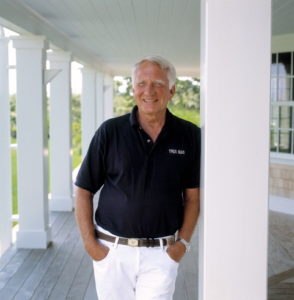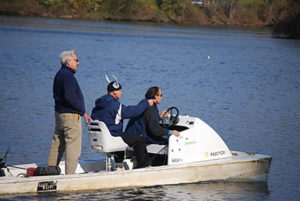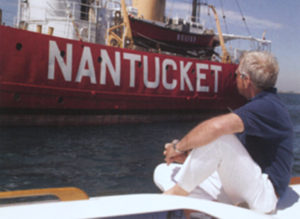 By Christopher Blackwall
By Christopher Blackwall
I have the good fortune to have formed treasured friendships with several of my clubmates at the University Barge Club — friendships that have led to many unforgettably shared experiences, occurring on and off the water, as well as at home and abroad. A long-term member and exemplar of this group is Lyman S. A. Perry.
Lyman is without question a multi-dimensional individual. Random highlights of his lengthy rowing career include stroking the US eight at the 1960 Rome Olympics, coaching the U. of Penn lightweights under legendary head coach Joe Burk, serving as president of UBC, and co-founding the Head of the Schuylkill Regatta with his fellow clubmate J. Pattison IV.
Yet, mastering the art and mechanics of rowing, and later serving the sport as an official, are by no means the only strings to Lyman’s bow. Like Leonardo Da Vinci, his Renaissance hero, he showed from a young age a keen interest in the structure of things and a talent for drawing. These two characteristics, along with a fierce inborn determination, eventually led Lyman to become a widely respected and highly successful architect.
Of the four dimensions that illuminate Lyman’s life story, Dimension #1 richly deserves the title True Navy Blue. It encompasses a deep and still active relationship with the United States Naval Academy, beginning with his birth, close to the campus in Annapolis.
Shortly after Lyman’s arrival in the world on August 22, 1938, his father, Lyman Spencer Perry, Sr., a career-long naval officer, became Athletic Director of the Academy. As a boy, Lyman developed enormous respect for his father, who in his own days as a midshipman had also been an All-American football player. Lyman determined to emulate him and in 1956 was himself accepted as a midshipman at the Academy.
His dreams of adding to his father’s football legacy were soon dashed. Though fit and athletic, he was deemed too small for the varsity squad. But when disappointment meets determination, a different way forward can often reveal itself; and Lyman took a spur-of-the-moment decision to check out the boat house — a move that changed his life.
Throughout his boyhood and teens, Lyman had spent many a happy day handling and racing sailboats, and sculling a dinghy, on the Miles River, across the bay from the Academy. So, when he stepped into the facility that accommodated Navy’s legendary crew program and saw the array of sleek wooden shells set out before him, he was instantly smitten and decided to join as a “walk on.”
It soon transpired that Lyman was a naturally gifted oarsman who could set and maintain an excellent rhythm. He ended up stroking Navy’s ‘57 Plebe Heavyweight eight to victory in that year’s IRA National Championship, and then stroked the Varsity Heavies to other notable successes in each of the following three years. Ultimately, as stroke oar, he led the Navy crew to win the Olympic Trials in 1960, and thus the US National title, followed by making the eight-oared final at the Summer Olympic Games in Rome, as previously mentioned.
Lyman’s relationship with the Naval Academy as an Olympic-level oarsman did not end in Rome, however. It continued until 1965, as detailed in Dimension #2, below. But other aspects of his deep connection to the Academy are still manifesting themselves over time, or even set to take place in the future.
Lyman has sponsored many a candidate for admission to the Academy and has been a consistent and generous donor to several funds that benefit the institution. In 2004 he was invited to become a trustee of the USNA Foundation, serving for over 14 years and recently elevated to emeritus status. He is also a donor member of the Robert Means Thompson Foundation, a member of the President’s Circle, and a founding donor to the Academy’s new Terwilliger Center, a 25,000 square foot education and training facility for student athletes.
Lyman’s love of sailing in general, all things Navy, and the Academy in particular, is also reflected in his ownership over the years of three beautiful yachts sequentially named True Blue I, II and III, and one spectacularly maneuverable Hinckley powerboat.
In 1963 Lyman, with the unusually junior rank of Lieutenant, was assigned by the Navy to take command of the USS Conger (SS477), a late World War II era diesel-electric submarine, on her last voyage to the Philadelphia Navy Yard to be scrapped (or as Lyman prefers to describe it, “rendered into razor blades.”)
As to the future, Lyman very recently learned of a great and rarely granted honor, conferred by the Superintendent of the USNA, in recognition of his familial and personal connections and distinguished service over the years. At a time that all their many friends and admirers fervently hope will be anything but soon, Lyman and his wife Kate will be laid to rest in the Academy’s cemetery, alongside his father and mother.
Dimension #2: Six Decades of Rowing and Sculling.
In addition to his stellar collegiate rowing career, Lyman’s first decade in the sport includes a brief second experience as an elite athlete when ordered to Philadelphia by the US Navy in the summer of 1963 to train for the 1964 Olympic Games. During this period, he joined the squad at College Boat Club of the University of Pennsylvania as stroke of Joe Burk’s elite eight, did some additional training at Fairmount R.A. and competed successfully as a sculler.
The pinnacle of his eight-oared performance in 1964 was twice beating Jack Kelly, Jr.’s renowned Vesper Boat Club eight that eventually won the Olympic trials that year, and ultimately the Gold Medal in Tokyo.
Lyman rounded out his first rowing decade with some emerging success as a coach. In 1964 the US Navy ordered him to return to the Naval Academy to teach navigation and to coach the lightweight plebes. After completing a successful first season, he was assigned to be Officer Representative for the full USNA squad at the 1965 IRA Championships in Syracuse, where he additionally filled in for the heavyweight plebe coach, who had taken a leave of absence. All three squads swept the IRA’s.
The early years of his second decade in rowing marked a transitional phase for Lyman. Between 1965 and 1968 he had resigned from the US Navy, gained admission to the University of Pennsylvania’s Graduate School of Architecture, was recruited by Joe Burk to coach Penn’s freshmen lightweights while in graduate school, and joined the University Barge Club. He finished the decade continuing to scull and in 1970 was elected President of UBC.

Lyman Perry, along with J Pattison and the late Raul Betancourt, launched the idea for the HOSR in 1970. Above, Perry, Blackwall and Budman conducting on-water operations at the HOSR.
While Lyman maintained his competitive sculling and occasional sweeping throughout the 1970’s, it was, of necessity, at a reduced intensity than before, due to his graduate study workload and, later, the pressures of establishing his career as an architect. Nevertheless, he found the time to give back to the sport in such ways as becoming a licensed referee and conceiving and organizing the first few iterations of the Head of the Schuylkill.
Along with his Olympic teammate Bill Knecht, Lyman also surveyed and laid out a six-lane rowing course on the Cooper River in Camden, which, after several major improvements, is now a top-class 2,000-meter competitive racing venue.
Throughout the succeeding decades, Lyman has been a regular masters’ competitor for UBC in eights, quads, doubles and singles across the USA, Canada, England, Ireland, Holland, Portugal, and the Czech Republic, winning many gold medals and simply “enjoying the opportunity to still be rowing.”
Dimension #3: Architecture.
As much as Lyman’s father might be described as his prime military mentor, his mother, Anna Abson Perry, an alumna of New York’s Parsons School of Design, was the muse who first noticed Lyman’s creative talents and nurtured their development. By the time he enrolled at the Naval Academy, Lyman had become an expert modelmaker and skillful draftsman.
Having resigned his Navy commission in 1965, his decision to enroll in Penn’s Graduate School of Architecture may have seemed a “shoe in” to Lyman, but his enrollment qualifications were at first questioned by the school’s academic faculty, led at the time by the iconic modern architect Louis I. Kahn.
Two factors eventually succeeded in resolving the faculty’s reservations about Lyman’s potential as an architect. The first was his determination. He set up and adhered to a rigorous self-study schedule, pausing only for his daily workout in the single. His rapid progress greatly impressed Carles Vallhonrat, Kahn’s right-hand assistant professor, who then successfully lobbied for Lyman’s full admission to the program.
Vallhonrat’s prescience was soon amply justified. Lyman won the school’s prize as best first-year student; and at his graduation in 1968, received the prestigious Paul-Philippe Cret Gold Medal, presented by Professor Kahn himself, who at his own graduation many years prior, had won the silver.
After his graduation, Lyman joined the Philadelphia firm of Bower and Fradley Architects. An early professional assignment involved researching and deciding the ideal placement within East Fairmount Park for three charmingly whimsical small statues. The location he chose was an open space between Kelly Drive and the Schuylkill River, not far from the imposingly large statue of General (and later President) Ulysses S. Grant, situated at the junction of Kelly and Fountain Green Drives. Officially titled the “Playing Angels,” the statues in question are more widely known — especially to rowers — as the Three Angels. To put them well beyond the reach of vandals, Lyman also designed and placed the tall, slender columns on which each Angel is carefully balanced.
A few years later, Lyman decided to form his own firm, Lyman Perry Architects. But of all the many successful projects the firm worked on in the almost 50 ensuing years, the one that Lyman considers his all-time favorite is his very first major commission: designing the main building of Benchmark School in Media, PA. Benchmark is a special co-educational school for children in grades 1 – 8 who have been identified as having reading difficulties and other learning challenges.
Whatever level of professional pride Lyman draws from his Benchmark project, it is surely enhanced by Kate’s leadership involvement with the school, which she co-founded in 1970 with Dr. Irene Gaskins, the visionary teacher who first posited the idea that such children should be empowered through their brightness, not held back by their difficulties; and who served as Head of School for the first 30 years of its existence.
Despite the time she has devoted to her continuing support of Benchmark, Kate has also found the time to pursue another of her passions to great success. She is internationally recognized as an outstanding breeder of championship Labrador dogs.
Dimension #4: Charm, Conviviality and Impishness.
Every friend of Lyman knows he is the embodiment of these three descriptors. Each is an excellent indicator that his many achievements notwithstanding, he knows how not to take himself too seriously. Socially relaxed, he is always fun to be around, and many of his friends have their own selection of Lyman stories. The following are three of mine.
Charm. On one of several memorable trips by a UBC Masters’ eight to race in London, a small group of us took a side day trip with the goal of touring Cambridge. On the way, we stopped to visit R.A.F. Duxford, a World War II airfield that now hosts an amazing collection of historic aircraft. We grossly overstayed our time there, and thus arrived in the heart of Cambridge as twilight was about to begin.
It was way too late for a college tour, and the local vendors of university swag were rolling down their shutters. Totally undaunted, Lyman put on his famously cheerful wide grin and persuaded the owner of one of the shops to reopen specially for us. We duly made the shopkeeper’s gesture commercially very worthwhile.
Conviviality. To quote Wikipedia, “Marmite has a very distinctive flavor. The taste is so unique as to defy description, but think of a yeasty, salty, soy sauce-like flavor with the consistency of old engine oil. Some people really like eating it, and some people don’t like eating it at all.” Well, on one of our UBC racing trips to England, Lyman tried it and liked it. Frankly, a little of it, spread thinly, goes a very long way.
Impulsively, Lyman bought the largest jar of Marmite he could find, lugged it back home and stored it at Little Pete’s on Fairmount Avenue, our group’s habitual breakfast nook after early morning rows. He made such a daily show of devouring it so lustily and offering to share it so liberally, that we renamed it “Lymanite” in his honor.
Impishness. In 1973, when he started his own architectural firm, Lyman also unexpectedly acquired a pet rabbit named Nimbus. In a dilemma about where to keep him, Lyman brought him to the office as a surprise, perhaps expecting one of his staff to adopt him. But Nimbus got the last laugh because he hit it off so well with the entire staff that he became the office mascot. Well cared for by the staff, he had the run of the office daily for almost ten years, a very good innings for a rabbit. If this was any kind of a backfire for Lyman, it is a fair bet that he took it with his customary good humor.
In fact, looking back on the nearly 40 years I have known Lyman, I don’t remember him ever greeting me with anything less than that delightfully impish smile.
~ By Christopher Blackwall
We are celebrating the HOSR’s 50th anniversary by highlighting 50 legendary competitors/crews/teams/coaches/influencers that have catapulted the regatta into a fall classic over the last 50 years. We celebrate the people by passing down their stories through generations, and affecting change for the future of our sport. We will publish a new stories throughout the year, continuing the celebration of our 50th anniversary, leading up to the 2021 regatta. Join us for our fifth Story Hour – The Tradition of Schuylkill River Coaching – on May 19th via Zoom. Register in advance.


